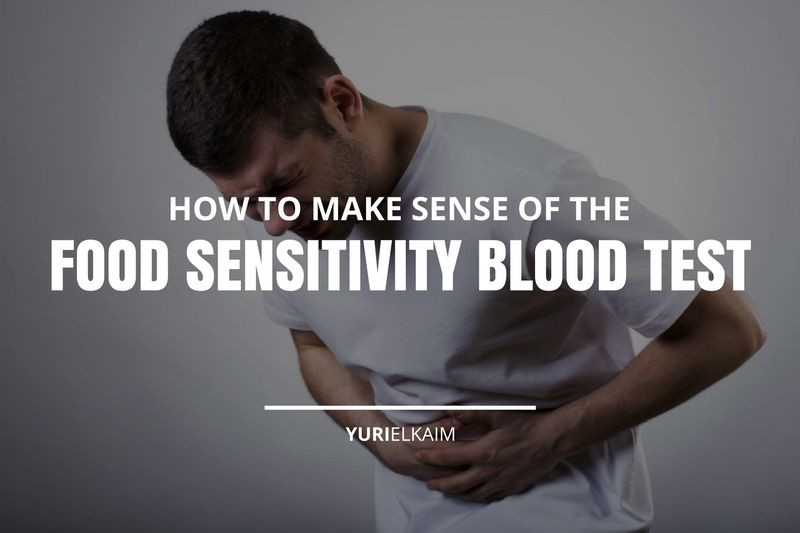In this article
If you’ve felt like “something was up” with your body, you might have decided to get a food sensitivity blood test.
Unexplained bloating, headaches, gas, brain fog, and low energy – all of these can be caused by sensitivities to foods we eat every day.
But many people aren’t aware that they have food sensitivities because they can be difficult to detect. They’re different from – and have different symptoms than – true food allergies.
You see, a true food allergy causes an immediate – and often deadly – reaction.
That’s because food allergies trigger the release of IgE antibodies, histamine, and cause life threatening conditions, such as anaphylactic shock.
But food sensitivities are a whole different ballgame.
It’s All About the Antibodies
Instead of releasing IgE antibodies, which are primarily found in the lungs, skin, and mucous membranes, food sensitivities release IgG antibodies, which are found in body fluids and the digestive tract. IgG antibodies work to protect the body against bacteria and viruses (1).
And because IgG antibodies don’t cause an instant reaction in the body (in some cases, symptoms can take up to 48 hours to surface) food sensitivities can be difficult to pinpoint.
Luckily, there’s a blood test for food sensitivities that can help detect these IgG antibodies, so you’re not left forever guessing. And I’ll explain how to make sense of the food sensitivity blood test in just a moment.
But first… what causes food sensitivities in the first place?
Why a Food Sensitivity Blood Test?
Now, this may sound silly at first. But one of the most common causes of food sensitivities is eating the same food repeatedly.
In fact, the constant craving for a specific food also suggests that you’re sensitive to it. As I’ve said before: the more of something you eat, the more sensitive to it you become.
Let me explain.
Your body requires specific enzymes to digest the foods you eat, which in most cases, it naturally produces.
But when you eat the same food repeatedly, you can begin to “deplete” your body’s stores of the specific enzyme needed for that food.
As a result, your body isn’t able to properly digest it. At this point, the undigested food can cause irritation and inflammation in your digestive tract, which is what causes an IgG reaction.
We can use dairy as an example here.
Irritating Your Digestive System
Many of us stop producing adequate amounts of the enzyme lactase, which is needed to digest the lactose found in milk, after the ages of breast-feeding.
It’s no coincidence that the majority of people today are sensitive to dairy, and report symptoms such as brain fog, bloating, and other digestive issues after consuming it.
[Related: The 5 Healthiest Dairy-Free Milk Alternatives]
Poorly digested food can also lead to food sensitivities by lingering in your digestive tract for long periods of time.
And since undigested food doesn’t belong in your digestive tract, bacteria will begin to putrefy it. Putrefaction can further irritate the gut lining and cause IgG reactions, which can lead to a host of other health issues.
As you can see, undetected food sensitivities can be a serious threat to your health.
If you’ve taken a food sensitivity test, or plan to take one in the future, here’s how to make sense of the IgG food sensitivity test.
How a Food Sensitivity Blood Test Works
When you get a blood test for food sensitivities, it will be an IgG/IgA test. As mentioned above, the food sensitivity test aims to detect these antibodies in your digestive tract.
Under normal circumstances, IgG antibodies are found throughout your body. In a typical IgG reaction to a virus or pathogen, IgG antibodies create what’s called an antibody-antigen complex (2).
Now, this complex doesn’t typically linger in the body after an initial reaction, and gets removed by cells called macrophages.
However, if you’re sensitive to a food that you’re eating each day, the antibody-antigen complex will accumulate and stick around. When high levels of IgG antibodies are present in your system, a food sensitivity blood test can detect which foods are causing this reaction.
When you get your food sensitivity blood test results back, the test will show you which foods caused an IgG response.
What to Do Next
And as you now know, a food sensitivity isn’t the same as a food allergy – meaning it doesn’t cause a life threatening reaction.
However, it’s still ideal to avoid the foods that show up as food sensitivities for at least 4 to 6 weeks, to see how your body responds without them in your diet.
This will also allow your body some time to build up your “enzyme bank,” which may allow you to continue eating a food you’re presently sensitive to, without any type of reaction down the road.
If you don’t feel you can completely cut the foods you’re sensitive to out of your diet, I recommend rotating the foods and avoiding eating them every day. Cutting down the amount of the food you’re eating is also important.
Build up your digestive “enzyme bank” by rotating your foods.
It’s crucial to detect food sensitivities because they’re a common cause of inflammation, and inflammation is the root cause of all illness and disease.
[Related: 19 Anti-Inflammatory Foods You Should Eat Each Week]
Food sensitivities have been linked to several inflammatory health conditions, including eczema, irritable bowel syndrome, and acne rosacea (3)(4).
You can get a blood test for food sensitivities done at an alternative health center, such as a naturopathic clinic. A food sensitivity blood test typically costs around $400, and may be covered by health insurance, depending on your plan.
Are Food Sensitivity Blood Tests Accurate?
I’ve been asked many times if a food sensitivity test is reliable.
And to be honest with you, getting an IgG/IgA food sensitivity blood test certainly won’t do any harm. It may provide you with some valuable insight for your health symptoms and offer new guidelines to apply to your diet and lifestyle.
After all, eating for energy is nearly impossible when you’re weighed down with food sensitivities.
However, any food that causes an unpredictable, delayed reaction in the body can be difficult for a test to detect. And with limited research on the accuracy of food sensitivity blood tests, it can also be efficient to listen to your body’s signs to determine food sensitivities.
It sounds simple, but one way of making it easier to listen to your body’s signs is by keeping a food and symptom journal. Tracking your energy levels, digestive function and mood each day, in addition to the foods you’re eating can help you make connections between certain foods and your symptoms.
A food and symptom journal can also help you take note of what foods you’re eating most often, which we sometimes don’t even realize we’re eating until we start keeping track.
There are various apps that can help you track your food intake and symptoms, such as mySymptoms Food and Symptom Tracker.
Consider An Elimination Diet
Also, an elimination diet can help because it removes suspected offending foods, and reintroduces them after a few weeks time to see how the body reacts. A a result, you can start to understand your body’s signs more clearly. An elimination diet should always be done with the help of a natural healthcare practitioner, such as a holistic nutritionist.
If you suspect you have true food allergies, you may also want to consider getting an IgE food allergy blood test done.
An IgE food allergy blood test can be done by your medical doctor, and is typically covered by health insurance. While an IgE test can’t detect food sensitivities, it may uncover allergies you never knew you had.
Pinpointing Troublesome Foods
While determining food sensitivities isn’t easy, it certainly isn’t impossible.
As you can see, taking a food sensitivity blood test is only one way to detect which foods may be causing your symptoms.
Keeping a food and symptom journal and considering an elimination diet can also help you pinpoint which foods to remove from your diet to feel your best again.
Start Feeling Better Now
Want a jumpstart when it comes to feeling less bloated and more energized? You’ll want to try my 1-Day Detox plan, which features a day’s worth of mouthwatering meals that are designed to help your body feel leaner and “cleansed.”
You can get the detox plan – for FREE! – by clicking the banner below.




